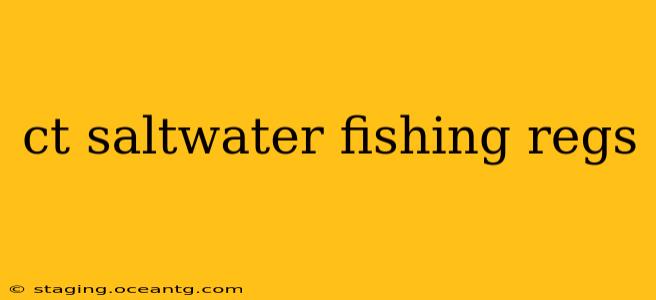Connecticut boasts a diverse coastline teeming with marine life, making saltwater fishing a popular pastime. However, responsible fishing requires understanding and adhering to the state's regulations. This comprehensive guide will walk you through the essential aspects of Connecticut's saltwater fishing regulations, ensuring you enjoy a successful and legal fishing experience.
What are the main Connecticut saltwater fishing regulations?
Connecticut's saltwater fishing regulations are designed to conserve fish stocks and maintain the health of the marine ecosystem. Key aspects include:
-
Licensing: While a Connecticut fishing license isn't required for saltwater fishing, you might need a license for certain species or to use specific fishing methods (like commercial fishing). Always check for any necessary permits or endorsements before you go. The Connecticut Department of Energy and Environmental Protection (DEEP) website is the best resource for the most up-to-date information.
-
Size and Bag Limits: These regulations specify the minimum and maximum size of fish you can keep, as well as the number of each species you're allowed to harvest per day or trip. These limits vary depending on the species and time of year. Carefully review the DEEP's regulations booklet or website before your fishing trip. Exceeding these limits results in significant fines.
-
Gear Restrictions: Certain fishing methods may be restricted or prohibited during specific seasons. For example, some areas may have limitations on the use of certain types of nets or traps. Understanding these restrictions is crucial for legal and ethical fishing.
-
Protected Species: Connecticut protects several species of fish, meaning you cannot harvest them. Knowing which species are protected is essential; unintentional capture and subsequent release is acceptable, provided you handle the fish carefully to maximize survival.
-
Seasonal Closures: Certain areas or seasons may be closed to fishing to protect spawning fish or other sensitive marine life. These closures are often announced well in advance. Checking for closures before your trip is a must.
What types of fish can I catch in Connecticut saltwater?
Connecticut's waters offer a diverse range of saltwater species, including:
- Striped Bass: A highly sought-after game fish with specific size and bag limits.
- Black Sea Bass: Popular among anglers, with size and bag limits carefully managed.
- Summer Flounder (Fluke): Another highly popular species with specific regulations regarding size and possession limits.
- Bluefish: Known for their aggressive feeding habits and exciting fights.
- Scup (Porgy): A common panfish, also subject to size and bag limits.
This is not an exhaustive list; many other species can be caught in Connecticut's waters. Always consult the DEEP's official regulations for a complete species list and associated limits.
How do I obtain a Connecticut fishing license? (If applicable)
While a general Connecticut fishing license isn't required for saltwater fishing, certain permits may be necessary depending on the species you are targeting or fishing methods employed. For example, you may require a permit for commercial fishing or to fish for specific protected species. Visit the Connecticut DEEP website for complete information on licenses and permits.
Where can I find the most up-to-date information on Connecticut saltwater fishing regulations?
The most reliable and up-to-date information on Connecticut's saltwater fishing regulations can be found on the official website of the Connecticut Department of Energy and Environmental Protection (DEEP). This is the primary source for all regulations, updates, and any changes. Always consult this resource before and during your fishing trip to ensure compliance.
Are there any special regulations for fishing in specific areas of Connecticut?
Yes, certain areas within Connecticut's coastal waters may have specific regulations in place due to environmental protection concerns or to manage fish populations effectively. These regulations can include size limits, bag limits, gear restrictions, or even seasonal closures. These localized regulations are often detailed on the DEEP website or in specific fishing brochures available at tackle shops or DEEP offices. Always check the regulations specific to your intended fishing location.
Remember, responsible and legal fishing practices are crucial for the sustainability of Connecticut's valuable marine resources. Always check the Connecticut DEEP website for the most current information. Enjoy your fishing trip!
